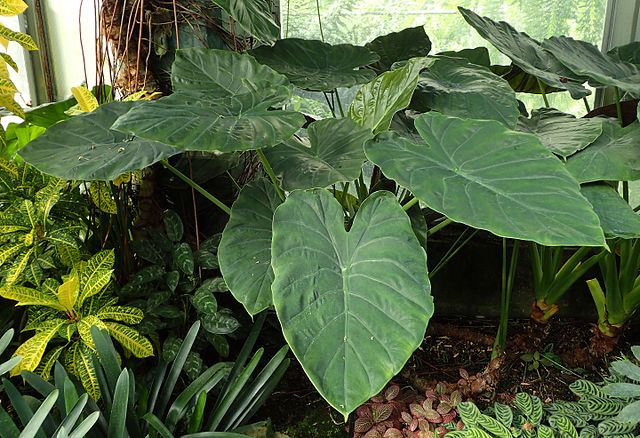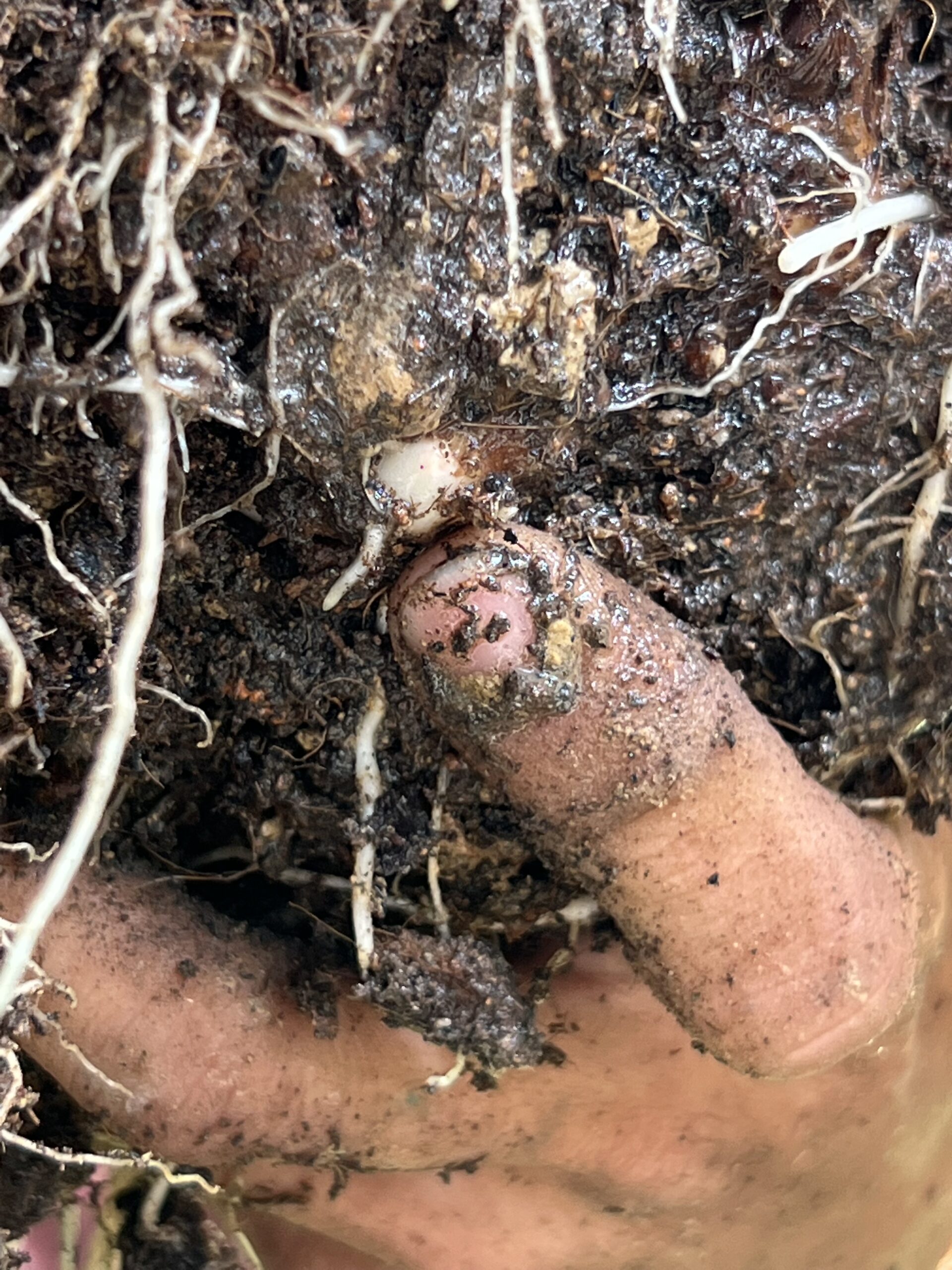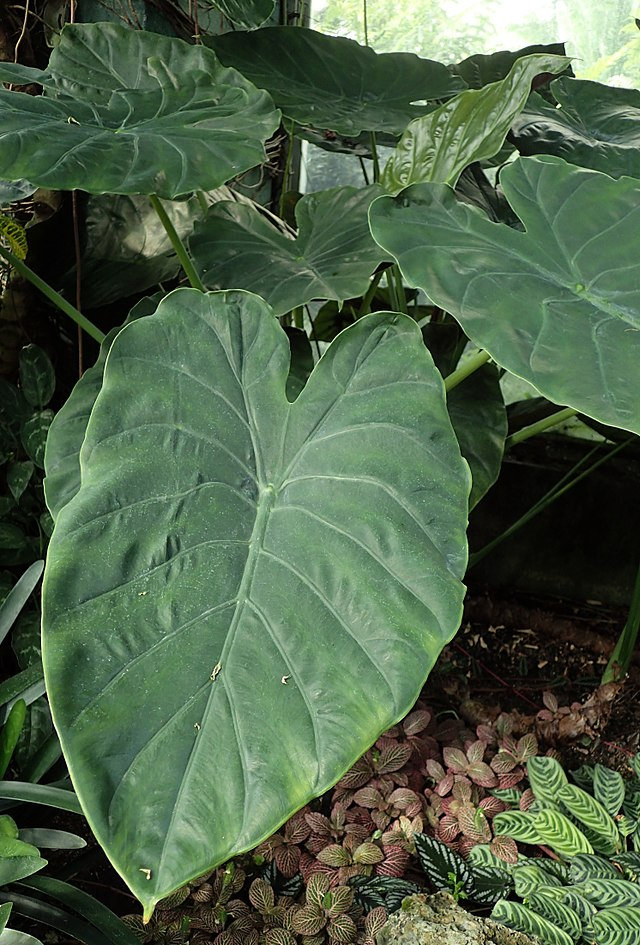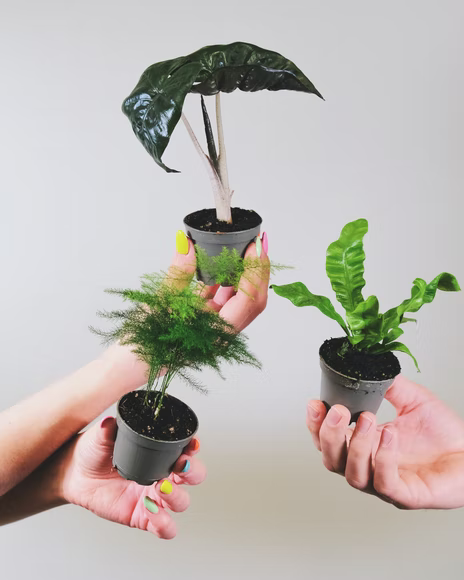Alocasia wentii, commonly known as “Hardy Elephant Ears,” is a beautiful houseplant for many reasons. Its striking green and purple foliage are the main reasons why this is sought-after by many plant enthusiasts. In addition, the massive Alocasia wentii looks excellent as a forest backdrop for an exotic showcase feel.
RELATED: 15 Breath-taking Types Of Calathea For Your Private Tropic Corner

Despite being one of those more straightforward Alocasia varieties, it is not a beginner’s plant. Instead, this plant requires specific care and attention.
The warmth-loving Wentii stays evergreen in warm weather while it turns dormant in cold weather, depending on the conditions. It is an excellent houseplant that may also be used as an outdoor landscaping plant.
Alocasia wentii Profile
General Information
Alocasia Wentii, also known as “Purple Umbrella,” “New Guinea Shield,” and, most commonly, “Hardy Elephant Ear,” is a hybrid of two Alocasia species, Alocasia gageana and Alocasia ordora. It is widely found in Southeast Asia and is widely known for its attractive beauty.
The plant is only found in tropical areas. The lovely color beneath the leaves is an adaptation to the mottled light of the Asian rainforest floor. The Hardy Elephant Ear gets its name from its enormous leaves. It features big, arrowhead-shaped leaves with an unusual color combination.
Etymology
Alocasia comes from the Greek word kolokāsiā, which means lotus root.
Flowering
These tropical beauties, like other plants, will blossom when they achieve maturity and are given ideal growth circumstances. Alocasia wentii is grown for its attractive leaves rather than its flowers because it rarely produces blossoms.
Its flowers are anthurium-like, consisting of a white sterile finger-like spadix surrounded by a pale yellow petal/modified leaf known as its spathe.
Season Of Interest And Purchasing
The Alocasia wentii plant actively grows during spring and summer and goes into dormancy during the winter. However, dormancy does not mean it is dead. Instead, think of it as the hibernation of plants. This will end up rightfully when the temperatures rise again. .
Growth
The plant may produce massive leaves in a shaded tropical environment. The foliage of this plant is stunning, with a bright green top and a metallic purple-bronze underside. Its broad leaves can grow to over a foot long.
When cultivated under the appropriate conditions, the mature Alocasia wentii plant may reach a height of 2 feet and a spread of 1.6 feet. This tropical beauty grows at a leisurely pace.
RELATED: Alocasia Mickey Mouse: A Useful and Complete Care, Propagation, and Watering Guide
Alocasia Wentii Overview
| Scientific name | Alocasia wentii |
| Common name/s | Hardy Elephant Ears, New Guinea Shield, Purple Umbrella |
| Family | Araceae |
| Growth Habit | Herbaceous |
| Height and Spread | Can have a height of up to 2 feet and a spread of 1.6 feet |
| Classification based on life cycle | Perennial |
| Origin and Distribution | Native range is Asia and Eastern Australia |
| Climate Zone | Generally warmer climate |
| USDA Plant Hardiness Zone | USDA Zone 9 – 11 |
| Color | Green arrowshaped foliage with reddish purple underside |
Care Tips

Light Requirement
Alocasia wentii plants thrive in bright, dappled light. Place your Alocasia wentii plant in a location where it will get indirect, filtered light. It is recommended that your Wentii plant be placed next to a south-west facing window. However, it does not work well in direct or bright light since the leaves may burn.
Using an artificial light to avoid dormancy during the winter season is another option.
Inadequate light will result in stunted development. Excessive direct sunshine, on the other hand, will burn the foliage. As a result, make sure your Alocasia plant is kept in proper lighting.
Temperature Requirement
The tropical Alocasia wentii grows well in temperatures ranging from mild to moderate. Because of this, it makes a great houseplant. The optimal temperature range for this plant is between 60 and 86 degrees Fahrenheit (16 and 30 degrees Celsius). Even if the temperature reaches 95 degrees, there will be no problem. But any more than that, it will start to have difficulties.
Its cold tolerance is slightly higher than other houseplants. However, it becomes strained if the temperature falls below 50 degrees. Therefore, both indoors and outdoors, low humidity environments must be avoided.
Water Requirement
This lovely house plant requires frequent watering. Maintaining a suitable balance between under and overwatering is essential for the healthy development of the Alocasia wentii. Watering once or twice a week throughout the summer and spring growth seasons is best. However, your plant’s watering requirements may vary when it is not actively growing or dormant throughout the winter months.
When it develops leaves during the growing season, it will also require continuously wet soil. However, avoid dry conditions since they give the plant more problems than most houseplants and eventually damage them.
Humidity Requirement
As is typical of a tropical plant, the attractive Alocasia wentii thrives in humid conditions. Therefore, maintain a 60 to 80 percent humidity level for best development and vivid leaves.
However, the plant may endure ordinary indoor humidity levels as low as 40 percent, depending on other circumstances such as sunlight and hydration.
If the plant is suffering from a lack of moisture in the air, the margins of its leaves will become brown. Here are a number of steps to increase humidity in your home.
- Adding a humidifier
- Putting it in a group of other plants
- Please put it on top of pebbles in a water tray or have some water containers nearby.
- Placing your plant where water is regularly used; it can be in the kitchen or in the bathroom.
Soil Requirement
The plant Alocasia wentii prefers moist, well-drained, and nutrient-rich soil. It flourishes in humidified, well-aerated environments. Using organic material is a great way to attain the consistency and fertility you want. Use coarse potting sand or a permeable soil mix made up of one part peat and one part perlite.
Maintain moist but not completely damp soil for the plant at all times. Soils that are too wet increase the risk of infection.
The ideal pH range is 5 to 8, which is acidic to slightly alkaline. Your plant will have total access to the nutrients it needs if you grow it at the proper pH.
Fertilizer Requirement
Since this particular Alocasia is a heavy feeder, it requires a lot of fertilizer. Feed Alocasia wentii with a balanced liquid fertilizer every two weeks in the spring and summer. Use a high-quality fertilizer with enough nitrogen, phosphate, and potassium levels.
During the growth season, the Alocasia wentii plant should be fed regularly. To avoid overfertilization, always dilute the prescribed strength to half. Overfertilization can cause root damage as well as leaf discoloration.
Space Requirement
The spacing required depends on the plant being grown. Your Alocasia wentii can be placed anywhere with enough room for them to spread out.
RELATED: Alocasia Imperial Red: A Plant Lover’s Care, Propagation, and Watering Guide
Growing And Planting Tips

Propagation
Alocasia wentii rhizomes are used to propagate the plant. The Alocasia wentii plant frequently produces offspring, making propagation relatively easy. The tiny plants that develop from the parent plant’s roots can be removed and grown as separate plants.
The best time to propagate Alocasia is during spring or the first part of summer.
Method For propagation
- Remove the plant by carefully digging around it with a shovel
- Prevent injuring the roots or rhizomes. Lift the plant gently from the ground; several tubers should be just beneath the surface .
- Clean the soil away and separate the tubers carefully.
- Next process, plant the rhizomes in a new place. Choose a location with rich, moist, loamy soil and some shade.
- Dig a hole just deep enough to accommodate the tuber.
- Give the young plant lots of water, and you should notice new growth in no time.
- If you’re growing alocasia plants in pots, make sure they’re kept warm and humid to get enough water.
Pruning
Alocasia wentii plants must also be pruned regularly. Though gorgeous, it may become untidy and ugly if not properly maintained. The most common reasons for pruning your plant are to trim it or to remove damaged leaves. Alocasia wentii plants have a greater leaf turnover than typical houseplants, so cut foliage is quickly replaced.
On the other hand, yellow leaves may make any plant seem boring and unpleasant. Also, if a leaf or vine has been infected with fungus or is sick, cut it off. Trim the leaves from the stem base, but be careful not to injure the new sprouts. Lastly, sterilized pruning shears should be used during pruning to avoid disease or infection.
Potting And Repotting
Alocasia Wentii prefers to be stacked neatly in a tiny pot. However, this plant does not require frequent repotting, but it is sometimes necessary. For example, if your plant has poorly become rootbound, it will need to be repotted. If you want to make your plants more appealing, place them in decorative pots and baskets.
Repotting your Alocasia plant is best done in the spring. This will aid in the total recovery of your plant. Do not repot it during the fall and winter months because the plant is dormant. Furthermore, the container’s size should never be increased by more than an inch or two. The root system will extend if the container is too big for the plant.
Alocasia Wentii Care Guide
| Light | Bright indirect |
| Temperature | 60-86 degrees Fahrenheit |
| Water | Once a week, increased in summer, decreased in winter |
| Soil | Well-draining and organic, moist soil |
| Fertilization | Once a month, no fertilization needed in winter |
| Space | Minimal space |
| Propagation | Via rhizome division |
| Blooming | Rarely blooms, enough sunlight and maturity needed |
| Pruning | When needed, removal of damaged and decaying leaves |
| Potting | Regular potting mix or Aroid mix, use of perlite and peat moss recommended, |
Pests And Diseases
| Common Pests/Diseases | Symptoms | Treatment and Prevention |
Common diseases include leaf spotting, root rotting, fungal diseases, stem and crown rotting. | Black or dark brown spots with yellow rim around | Do not overwater and maintain proper humidity levels. Extremely wet environments enhance fungal growth.Proper ventilation is necessary. Removal of infected plant parts to avoid spreading of disease. |
| Common pests include aphids, scales, mealybugs, spider mites | Visible insects thriving on surface | Warm, soapy water can be sprayed once a month. Neem oil, herbal spray, or commercial insecticides can also be used. |
Problems And Troubleshooting
Overwatering
Drooping or yellowing leaves are a common problem with Alocasia species. One probable reason is overwatering. The Alocasia wentii plant is also prone to root rot, especially when the plant has been irrigated excessively. To avoid or limit root rot, water the plant only when the top few inches seem dry.
Make sure that your watering and feeding schedule is correct, and make any necessary adjustments.
Underwatering
Alocasia Wentii thrives in damp soil and will droop if it becomes fully dry. If the soil dries out, it will take a few days for the soil to absorb water. Brown, crispy edges are another indicator of underwatering. This happens when moisture does not reach the leaf’s edges. Due to a lack of moisture, it also becomes weak and unstable.
So, keep a consistent watering schedule for your plant and keep an eye on it on a frequent basis.
Here are some suggestions for fixing your under-watered plants:
- Water it slowly and consistently to avoid shocking your plant.
- Remove the plant from the container.
- After that, place your Alocasia in the tub and soak it in water.
- Remove the plant after the soil is moist and set it in a sunny position
Nutrient Deficiency
Common nutrient deficiencies in other plants do not exclude this exotic plant. Nutrient deficiencies usually manifest as yellowing of leaf surfaces or crispy edges, holes, burnt leaves with brown tips, purplish hues on leaves, brown spots, distorted leaves, soft texture, and stunted roots.
To fix this, the right and balanced fertilizer must be used. A nutrient strength that is too strong may also be as detrimental as nutrient deficiency, so this should be kept in check. Soil pH is also essential since it is a significant factor in the plant’s nutrient uptake.
Flowering Problems
Alocasia plants generally do not have regular flowering seasons; thus, it helps to not rely on flowering time. To ensure that your plants produce flowers, ensure that optimum care and requirements are given and sufficient lighting, which is crucial for flowering.
Problems with People and Animals
Toxicity
The foliage and stem of Alocasia plants contain calcium oxalate crystals which can induce irritation and swelling in the throat and mouth of humans and animals. These irritations and swelling may cause death due to airway blockage in the worst-case scenario.
Alocasia Plants Meaning And Symbolism
Alocasias are said to be “trees that grow up to the heavens”, even though botanically speaking they are not trees. With this, black velvet symbolizes seizing opportunities and taking risks. They are perfect gifts for people who are about to make major life decisions such as moving into a new city or venturing into a new business.
| General Meaning | “plant that grows up to heavens” |
| Symbolism | Risk taking and seizing opportunities |
| Cultural Significance | Attribution to the Jack and the Beanstalk fairytale |
Landscaping And Gardening Ideas

Companion Plants
Other Alocasia plants such as Silver Dragon and African Mask, Caladiums, Colocasia, and Xanthosoma make great companions to these plants. In addition, many plants like Canna lilies, decorative bananas, Dieffenbachia, Ficus, Schefflera, and Coleus, may also be planted with Alocasias as they exude the same tropical scenery vibe.
Landscaping Ideas
In gardens, Alocasias can be on the perennial borders. Its foliage, shaped like elephant ears, is a good break from the rest of the plants, especially those with colorful hues. In terrariums and vivariums, it can be in the center with other foliage and flowering plants.
This plant with dark leaves can also be with plants with purple hues or stiff texture, which provide more drama when juxtaposed with the dark green leaves of Alocasias.
| What to plant with | Colocasia, Caladiums, Alocasias, Xanthosomas, Coleus, Canna Lilies, Ornamental Bananas, Ficus, Dieffenbachia, Schefflera |
| What NOT to plant with | Basically nothing |
Conclusion
Alocasia wentii is a beautiful plant with huge, distinctive green and purple leaves that flow beautifully over tall, long stems. It is an excellent houseplant that also works well as an outdoor landscaping plant in warm, humid regions.
Like many other Alocasias, the foliage of this plant is to die for. Make sure you have one of these valuable plants in your collection!
FAQS
Are Alocasia wentii hard to care for?
Alocasia wentii plants are not the easiest to care for, but surely not the hardest. The plant needs reasonable care and attention to thrive and could be a little fussy when the environment is not at its optimum. However, first-time plant collectors can still have this in their homes.
Should I cut off the Alocasia wentii flower?
It depends on you. You can leave the flower and admire its rare beauty. However, flowers take much energy from the plant, and thus often, flowering involves the dropping of some leaves. Cut the flowers off if you care for much healthier foliage and faster new growth, especially in the growing season.
How often should you water Alocasia wentii?
Alocasias are very water sensitive. Therefore, it is imperative to water this Alocasia only once during cold seasons and up to three times a week during hot seasons. As a general rule, you may check the top 3 inches of soil and only water when it is scorched. Overwatering causes too moist conditions that will invite more spider mites and microorganisms.
Does Alocasia wentii bloom?
As an angiosperm, Alocasias produce an anthurium-like flower called a spadix. However, the flowers of Alocasias are insignificant as they rarely bloom. They are collected mainly by their distinct foliage.
What soil does Alocasia wentii need?
A well-draining soil that contains large chunks which are suitable for aeration and drainage is what Alocasia wentii loves. A standard jungle or aroid mix will surely make your plant thrive.
Do you have other tips on how to take care of Alocasia wentii? Share it with us below in the comment section. Also, check out our other articles:
Anthurium crystallinum: The Only Care, Propagation, and Watering Guide You Need
Philodendron McColley’s Finale: Care, Watering, and Propagation Guide
How To Grow & Care For Your Monstera Plant? The Ultimate Guide







